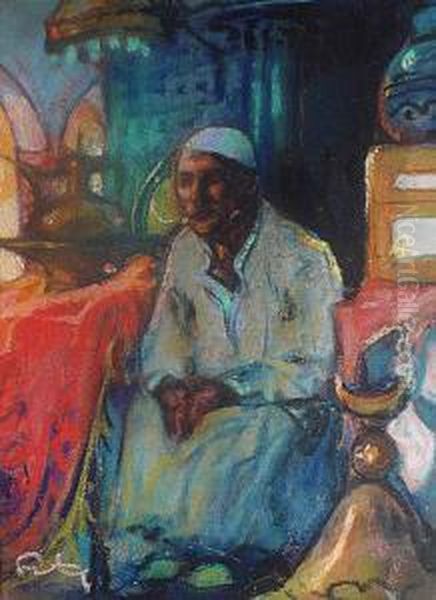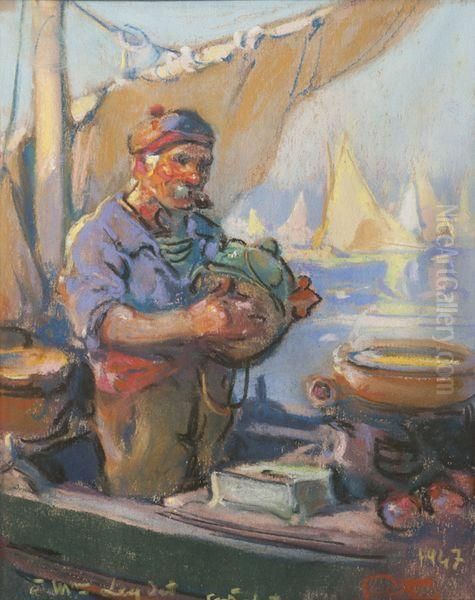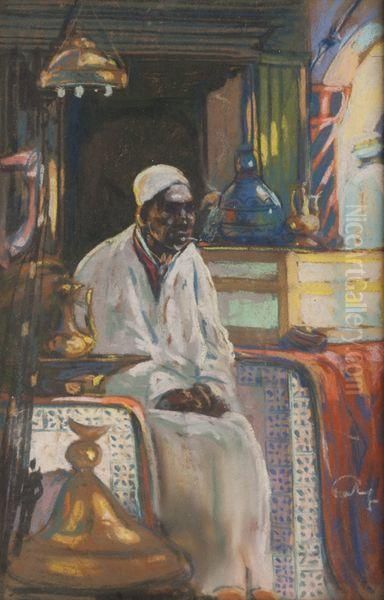Louis Fortuney, an artist whose life spanned from 1878 to 1950, remains a notable figure in French art of the late 19th and early 20th centuries. A dedicated painter, printmaker, and, most significantly, a virtuoso pastellist, Fortuney carved a niche for himself with his delicate and evocative portrayals of everyday life, particularly the elegant women and bustling scenes of Paris. His work, while not always aligned with the radical avant-garde movements of his time, possesses a timeless charm and technical brilliance that continues to attract admiration.
Artistic Genesis and Parisian Milieu
Born in France, Louis Fortuney emerged as an artist during a period of immense cultural ferment. Paris, the undisputed art capital of the world, was a crucible of innovation, witnessing the twilight of Impressionism, the rise of Post-Impressionism, Fauvism, and the birth of Cubism. Artists like Claude Monet and Pierre-Auguste Renoir were established masters, while younger talents such as Henri Matisse, André Derain, Pablo Picasso, and Georges Braque were actively reshaping the landscape of modern art.
Fortuney, however, seemed to navigate this dynamic environment by focusing on a more intimate and observational approach. His artistic inclinations led him to master the medium of pastel, a choice that allowed for both immediacy and a remarkable subtlety in rendering textures and light. This medium, famously employed by predecessors like Edgar Degas and Mary Cassatt for its vibrant and direct qualities, found a new exponent in Fortuney.
The Allure of Pastel and Thematic Focus
Pastel became Fortuney’s signature medium. He demonstrated an exceptional ability to capture the soft luminosity of female skin, the intricate drape and sheen of fabrics, and the fleeting atmospheric conditions of his chosen scenes. His technical prowess allowed him to convey a sense of tactile reality, making his figures and their environments come alive with a gentle vibrancy.

His thematic concerns were deeply rooted in the world around him. The streets of Paris, with their fashionable inhabitants and everyday dramas, provided a rich tapestry for his art. He was particularly drawn to depicting women – elegant Parisians strolling through parks, engrossed in quiet domestic activities, or captured in moments of candid repose. These portrayals were not merely illustrative; they often conveyed a sense of mood and character, hinting at the inner lives of his subjects. Works like La Couturière (The Seamstress) exemplify this focus, showcasing a quiet moment of labor with sensitivity and grace.
Beyond the urban sphere, Fortuney also explored other subjects. Scenes from markets, such as La Vendeuse de legumes au marché (The Vegetable Seller at the Market), demonstrate his keen eye for social observation and his ability to find beauty in the mundane. His travels also informed his work, with pieces like Marchand dans le souk de Tunis (Merchant in the Tunis Souk), dated 1921, and Le Jeune arabe (The Young Arab) indicating an interest in Orientalist themes, a genre that had captivated French artists since the 19th century, from Eugène Delacroix to Jean-Léon Gérôme.
The Influence of Cagnes-sur-Mer and Auguste Rodin
A significant aspect of Fortuney's artistic development was his connection with the renowned sculptor Auguste Rodin. It is documented that Fortuney was invited by Rodin to Cagnes-sur-Mer in the South of France. This region, with its brilliant Mediterranean light and picturesque landscapes, had become a haven for artists. Renoir, for instance, spent his later years in Cagnes, and artists like Chaim Soutine and Amedeo Modigliani also worked there at various times.
The time spent in Cagnes-sur-Mer and the association with a figure of Rodin's stature undoubtedly had a profound impact on Fortuney. The southern light likely influenced his palette, perhaps encouraging a brighter range of colors and a more pronounced exploration of light and shadow, evident in works depicting coastal scenes like Barque en bord de côte (Boat at the Edge of the Coast) and Barques de pêche accostées en mer Méditerranée (Fishing Boats Moored in the Mediterranean Sea). The latter, often priced attractively at auctions, showcases his ability to capture the maritime atmosphere.
While Rodin was primarily a sculptor, his emphasis on capturing life, movement, and emotional expression would have resonated with a painter like Fortuney. This mentorship or close association provided not only artistic stimulus but also likely facilitated connections within the broader art community.
Key Works and Stylistic Characteristics

Fortuney's oeuvre is characterized by its consistent quality and dedication to the pastel medium. His style can be broadly situated within the traditions of French Realism and Naturalism, but with a distinctively gentle and often poetic touch. He was less concerned with radical formal experimentation than with capturing the perceived reality of his subjects with finesse and sensitivity.
Several works stand out as representative of his artistic concerns:
Le Jeune arabe: This piece highlights his skill in portraiture and his engagement with subjects beyond the Parisian sphere, rendered with his typical delicacy.
La Couturière: A quintessential example of his intimate portrayals of women engaged in everyday activities, showcasing his mastery of fabric and quietude.
La Vendeuse de legumes au marché: Demonstrates his ability to capture the vibrancy of street life and the character of working people.
Marchand dans le souk de Tunis (1921): Reflects his travels and the enduring European fascination with North African scenes, handled with his characteristic pastel technique.
Le vague (The Wave) or La vague: This work, often commanding higher prices, suggests an engagement with the power and beauty of nature, specifically the sea, rendered with dynamic energy.
Le pêcheur, les joueurs (The Fisherman, the Players), dated 1947: A later work, indicating his continued artistic activity and interest in genre scenes.
Guitare à la fleur (Guitar with Flower): Suggests an exploration of still life, a common genre for artists to explore form, color, and texture.
Homme fumant (Smoking Man): A character study, likely capturing a candid moment with psychological insight.
His technique involved a careful layering of pastel strokes, achieving both precision in detail and softness in overall effect. He understood how to use the texture of the paper support to enhance the visual qualities of the pastel, allowing for broken color effects or smooth, blended passages as the subject required. His palette was often nuanced, capable of capturing both the muted tones of an interior scene and the brighter light of an outdoor setting.
Public Commissions and Recognition

Beyond his easel paintings, Louis Fortuney also received significant public recognition in the form of commissions. Notably, he was entrusted with creating decorative murals for the French Admiralty in Paris. This was a prestigious undertaking, indicating the high regard in which his artistic abilities were held by official circles. Such commissions were often awarded to artists who had demonstrated exceptional skill and a style that was considered appropriate for important national buildings. This achievement places him in a category of artists who contributed to the public artistic heritage of France, a tradition that included muralists from earlier generations like Pierre Puvis de Chavannes.
His works have consistently appeared in the art market, particularly at auctions in France. The prices his pastels command, while varying depending on size, subject, and condition, reflect a steady appreciation for his skill. Auction houses like Maison R&C and sales in Saint-Germain-En-Laye have frequently featured his pieces, contributing to his posthumous visibility.
Fortuney in the Context of His Time
Louis Fortuney operated in an era of artistic pluralism. While he may not have been a revolutionary in the vein of Picasso or Matisse, his work holds its own distinct place. He can be seen as part of a lineage of artists who valued keen observation and technical mastery in depicting the world around them. His focus on Parisian life and feminine subjects aligns him with artists like Jean Béraud, who also specialized in capturing the nuances of Belle Époque Paris, or James Tissot, though Fortuney's touch was often softer and more intimate than Tissot's polished society portraits.
His dedication to pastel connects him to the great tradition of this medium in France, from 18th-century masters like Maurice Quentin de La Tour to 19th-century innovators like Degas. While Degas used pastel with a bold, often experimental approach to capture movement and modern life, Fortuney employed it with a more classicizing finesse, emphasizing harmony and delicate beauty.
He was a contemporary of artists who explored similar themes of urban life and leisure, such as members of the Nabis group like Pierre Bonnard and Édouard Vuillard, who often depicted intimate interior scenes, though their stylistic approaches, with their emphasis on pattern and subjective color, differed significantly from Fortuney's more naturalistic renderings. Even artists working in a more academic tradition, or those who, like Kees van Dongen (though a Fauvist), were known for their striking portraits of women, formed part of the diverse artistic ecosystem in which Fortuney worked. His art offers a counterpoint to the more radical movements, representing a continuation of refined observational painting that appealed to a significant segment of the art-loving public.
Later Career and Enduring Legacy
Fortuney continued to produce art throughout the first half of the 20th century, with works dated as late as 1947, such as Le pêcheur, les joueurs. This indicates a sustained period of artistic activity, adapting perhaps subtly to changing times but remaining true to his core artistic vision and preferred medium.
The legacy of Louis Fortuney lies in his exquisite body of work in pastel. He was a master of this demanding medium, using it to create images of enduring charm and sensitivity. His depictions of Parisian women, street scenes, and Mediterranean landscapes offer a window into his time, filtered through a distinctly personal and refined artistic sensibility. While perhaps not as widely known as some of his more revolutionary contemporaries, his art maintains its appeal through its technical brilliance, its gentle beauty, and its honest engagement with the visible world.
His influence might be seen less in the founding of a new school or movement, and more in the continuation of a tradition of high-quality figurative art that valued craftsmanship and subtle observation. For collectors and admirers of French art from this period, particularly those with an appreciation for the art of pastel, Louis Fortuney remains an artist of considerable interest and merit. His works serve as a testament to the enduring power of skilled representation and the quiet beauty that can be found in the everyday.
Conclusion
Louis Fortuney (1878-1950) was a distinguished French artist who excelled as a painter, printmaker, and notably, as a pastellist. His art, characterized by a delicate touch and keen observation, primarily focused on the daily life of Paris, particularly its female inhabitants, as well as landscapes and scenes from his travels. Influenced by his time in Cagnes-sur-Mer and his association with Auguste Rodin, Fortuney developed a refined style that, while not part of the major avant-garde currents, earned him recognition, including commissions for public murals. His mastery of pastel allowed him to capture subtle textures, light, and mood, creating works like La Couturière, Le Jeune arabe, and La Vendeuse de legumes au marché that continue to be appreciated for their technical skill and gentle charm. He remains a significant figure for those who value the nuanced beauty of early 20th-century French figurative art.